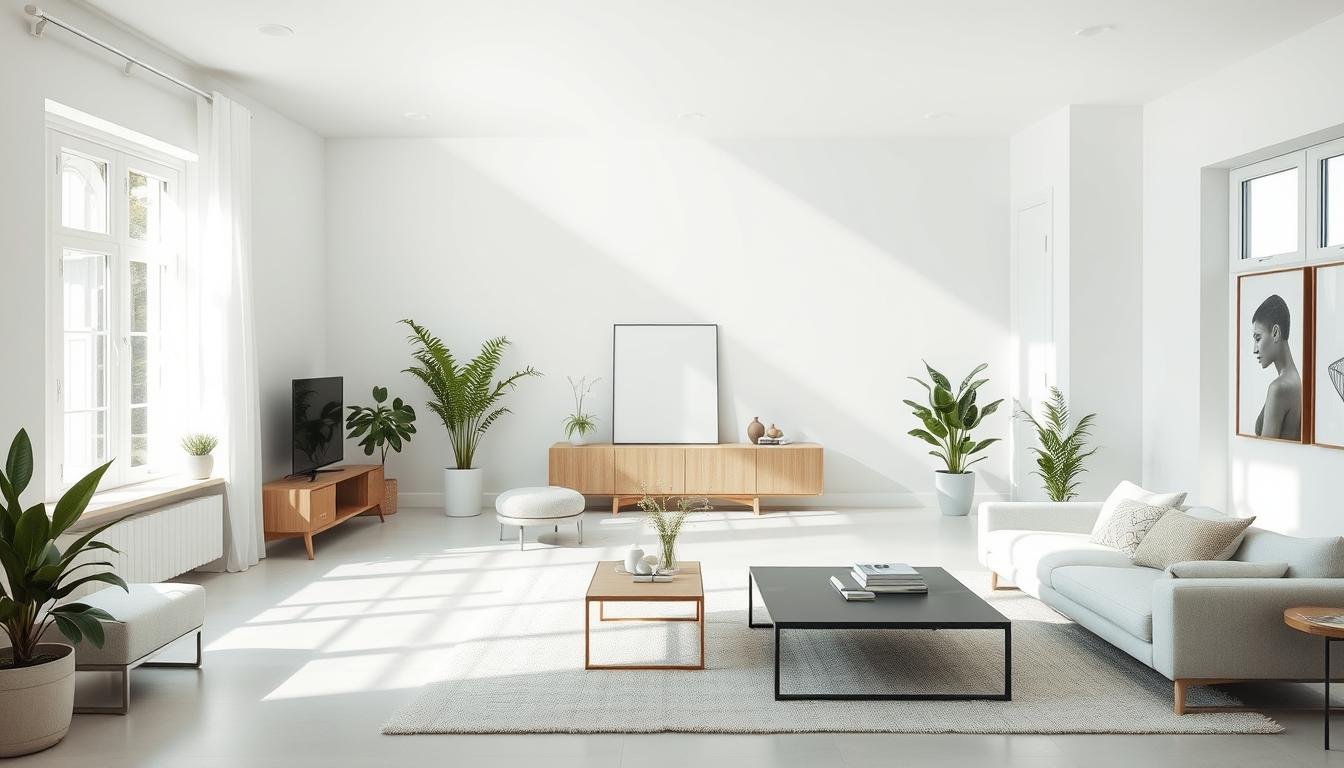Some links on this page are affiliate links. This means we may earn a commission at no additional cost to you if you click through and make a purchase. Thank you for your support!
Declutter for a minimalist home is something we all think about. But starting can seem too hard. Today, we’re going to tackle this together. We’ll learn how to declutter and make your home a place of joy.
Walking through my living room, I feel uneasy. Clutter piles up, drawers overflow, and everything feels noisy. I dream of a simple, peaceful space. Do you feel the same way?
We’ll look at practical ways to simplify your space. You’ll see how living simply can change your life. Get ready to clear out clutter and refresh your mind and soul.
Understanding the Basics of Minimalist Living
Minimalism is more than just cleaning up your home. It’s a way of life that makes you think about what you really need. Unlike simple decluttering, minimalism helps you find the right amount of things to support your goals and values. This approach can bring many benefits, like freeing up resources and rejecting too much stuff.
What Makes Minimalism Different from Simple Decluttering
Decluttering is about getting rid of things you don’t need. But minimalism asks why we have so many things in the first place. It’s about finding the perfect amount of stuff to live a happy life, not just getting rid of obvious clutter. This different way of thinking makes minimalism unique and helps you make lasting changes.
Benefits of Embracing a Minimalist Lifestyle
- Freeing up time, money, and mental energy by reducing possessions
- Rejecting the cycle of consumerism and focusing on what truly matters
- Experiencing a greater sense of self-discovery and personal growth
- Reducing your environmental impact by consuming less and generating less waste
Setting Realistic Minimalist Goals
When you start your minimalist journey, set goals that fit your life. Start with one area, like your closet or kitchen, and then add more. Remember, minimalism is different for everyone, so make it your own. Start small and build up, rather than trying to change everything at once.
Understanding minimalism and setting reachable goals can start a big change in your life. It’s a journey to a more intentional, fulfilling, and simple life. Trust your instincts and go with what feels right to you.
Getting Started: Essential Preparation Steps
Starting your decluttering journey is an exciting step. It leads to a more minimalist, organized, and serene home. Before you begin, take time to assess your current situation and set clear goals. Capture the clutter with photos to track your progress and stay motivated.
Reflect on how your home makes you feel now. Do you feel overwhelmed by too many belongings? Or do you feel calm and easy in some areas? Write down your thoughts and feelings to understand your decluttering motivation. This self-awareness will help you set realistic goals for your minimalist home.
When starting, don’t tackle the toughest areas first. Begin with something manageable, like a junk drawer or a small closet. Winning these small battles will boost your confidence and drive you to tackle bigger home organization tasks.
Get your supplies ready, such as boxes, bags, and labels. This will make sorting easier. Remember, any action you take will greatly improve your space and make your home cozy and inviting.
“The journey of a thousand miles begins with a single step.” – Lao Tzu
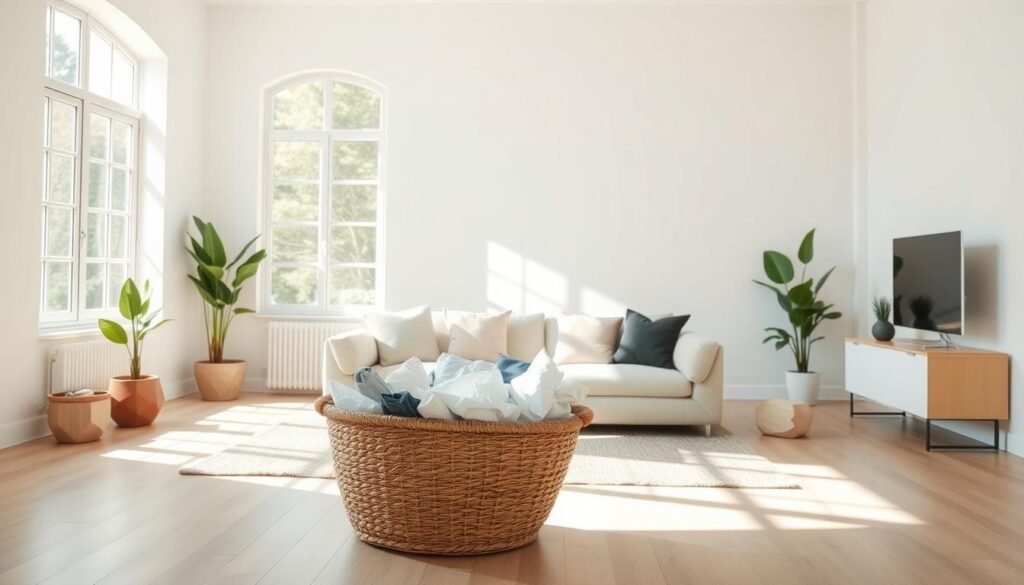
The Four-Box Method: A Systematic Approach to Declutter
Decluttering can seem daunting, but the four-box method makes it easier. It divides items into four boxes: donate/sell, garbage, recycling, and “bring home.” This method helps you make fast decisions and stay organized.
Donate/Sell Box Strategy
For the donate/sell box, price items low, about 20% of their original value. This makes it easier to let go of items. Only sell items worth more than $30 to save time and effort.
Garbage and Recycling Sorting
Sorting items for garbage and recycling is key to reducing waste. Check your local recycling guidelines to dispose of items correctly. The “garbage” box is for items that are broken or damaged.
The “Bring Home” Box Concept
The “bring home” box is for items that belong elsewhere in your home. It’s for a misplaced kitchen gadget or a book that needs to be returned. This box helps you keep your decluttering process efficient.
The four-box method is popular for its simplicity and effectiveness. It helps you declutter quickly, reduce clutter, and move towards a minimalist lifestyle.
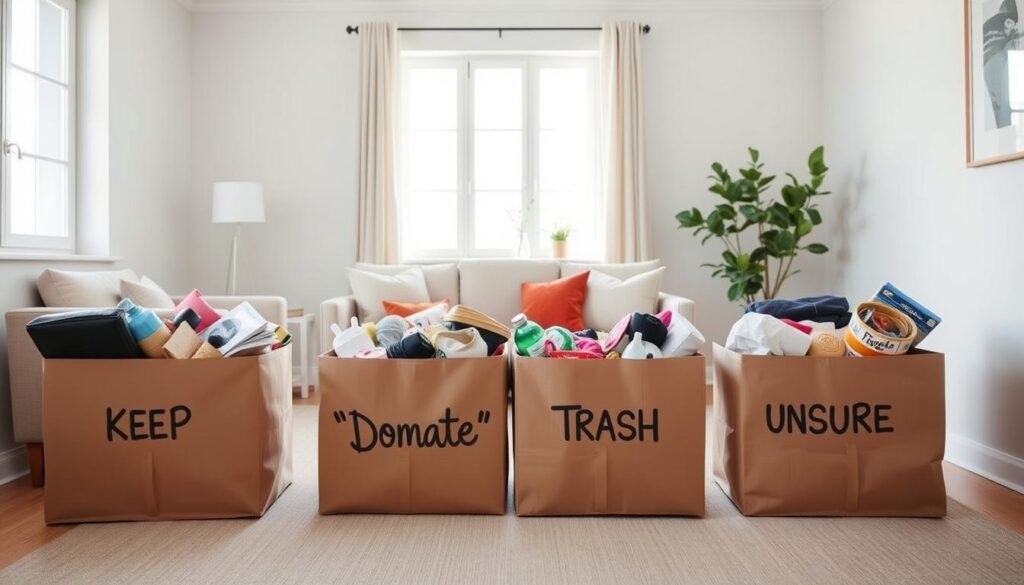
Declutter for a Minimalist Home: Room-by-Room Strategy
Creating a minimalist home is easier than you think. The author of “The Minimalist Home” offers a step-by-step guide to decluttering. This method helps you simplify your space, one room at a time.
Begin with a small area like a drawer or shelf. Then, move on to bigger spaces. Use the “penalty box” method to decide on items you’re unsure about. Set them aside for 1-6 months. After that, decide if you really need them or if they can be given away.
Take before and after photos to see your progress. Don’t forget to high-five yourself after completing each room!
- Start with the easiest areas, such as the entryway, guest room, or home office.
- Move on to more personal spaces, like the bedroom, bathroom, and closets.
- Tackle the kitchen, which can be a hotspot for accumulating clutter.
- Finish with the living room, where we often hold sentimental attachments to our possessions.
Decluttering room by room makes it easier to achieve a minimalist home. This approach helps you create a space that is peaceful and organized. Embrace the idea that less is more and enjoy your new, serene home.
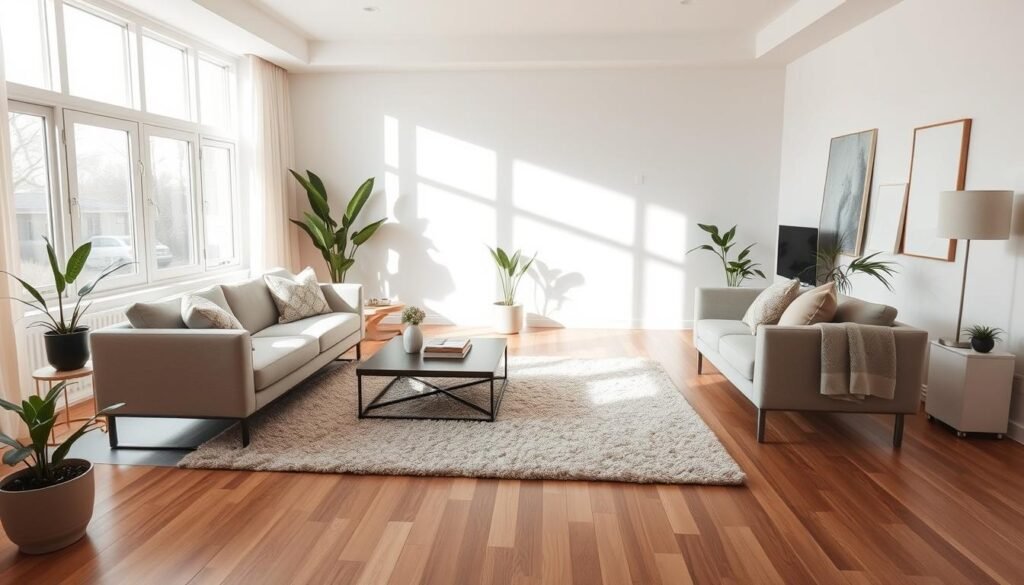
“Decluttering is not easy, especially when it involves items with sentimental value. But the rewards of a simpler, more fulfilling lifestyle make it well worth the effort.”
| Room | Decluttering Priorities | Estimated Time |
|---|---|---|
| Entryway | Coats, shoes, bags, keys | 1-2 hours |
| Bedroom | Clothing, linens, personal items | 3-4 hours |
| Bathroom | Toiletries, medicines, towels | 1-2 hours |
| Kitchen | Utensils, appliances, pantry items | 4-6 hours |
| Living Room | Books, electronics, decor, media | 3-5 hours |
Creating Clutter-Free Zones and Maintaining Them
Creating clutter-free spaces is key for a minimalist lifestyle. Start by picking areas that often get messy, like the kitchen counter or living room. Make these spots clutter-free zones and keep them that way.
Establishing Protected Spaces
Start small, like with a single shelf or table. Then, grow your clutter-free areas. Keep these spaces clean with daily routines. For example, use a “inbox” for papers to stop them from spreading.
Make it a habit to find homes for five misplaced items daily. Spend just five minutes decluttering each day. These small steps will keep your clutter-free space tidy and prevent clutter accumulation.
Daily Maintenance Routines
Living minimally is key to keeping your organized home. Watch your spending and avoid buying on impulse. Borrow items from family and friends instead of buying new.
Try a shopping ban for a few weeks to stop buying too much. When you bring something new home, get rid of something old. This stops your stuff from piling up.
Preventing Clutter Accumulation
Assign a spot for each item in your home. This makes it easier to keep things tidy. Have a small wardrobe with clothes you love and can mix and match. This reduces buying too much.
By following these home organization hacks, you can keep your home clutter-free and peaceful.
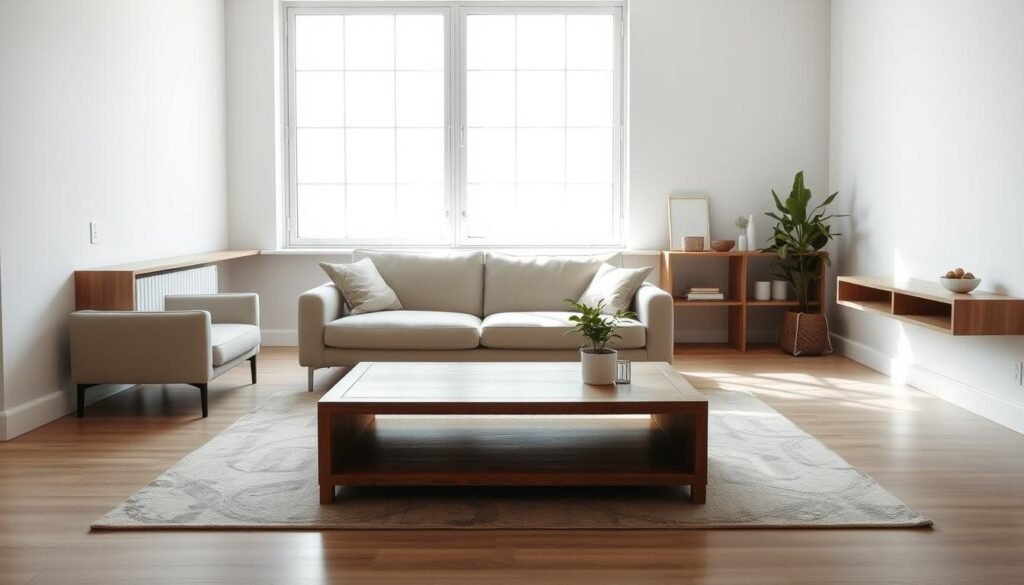
“Over the past several years, almost every room in my home now rests in a state of order, free from physical clutter.”
Making Quick and Effective Decluttering Decisions
Decluttering your home for a minimalist lifestyle is more than just getting rid of stuff. It’s about making choices that match your values and goals. By asking a few key questions, you can make the decluttering process easier. This way, you can create a space that truly reflects your minimalist vision.
- Do you like the item? If not, it’s time to let it go. Minimalist living means having things that make you happy and serve a purpose.
- Do you need the item? Be honest about whether you really need something or if it’s just nice to have. Choose essential, multi-functional items over single-use or redundant ones.
- Do you use the item? If something has been untouched for months or years, it’s likely time to get rid of it. Decluttering helps simplify your lifestyle and get rid of unused stuff.
- Is the item a “unitasker”? Minimalists prefer versatile, multi-purpose items over specialized tools and gadgets. Consider letting go of these “unitaskers” to simplify your possessions.
Deciding on sentimental items can be harder. Ask if anyone would really want the item when you’re gone, or if you want to keep it forever. Remember, your environment matters. Surround yourself with possessions that truly serve a purpose or bring you joy.
| Decluttering Statistics | Insights |
|---|---|
| 59% of American households live paycheck to paycheck | Decluttering and adopting minimalism can help build emergency savings |
| Nearly half of survey participants carry credit card debt | Minimizing possessions can alleviate financial burdens |
| Decluttering 1-2 items per day can lead to 365-730 items decluttered annually | Small, consistent actions can create a significant impact over time |
The decluttering process is unique to each person and may need multiple tries to reach a minimalist state. By making quick and effective decisions, you can simplify your lifestyle. This way, you can create a space that matches your minimalist decor and decluttering checklist.
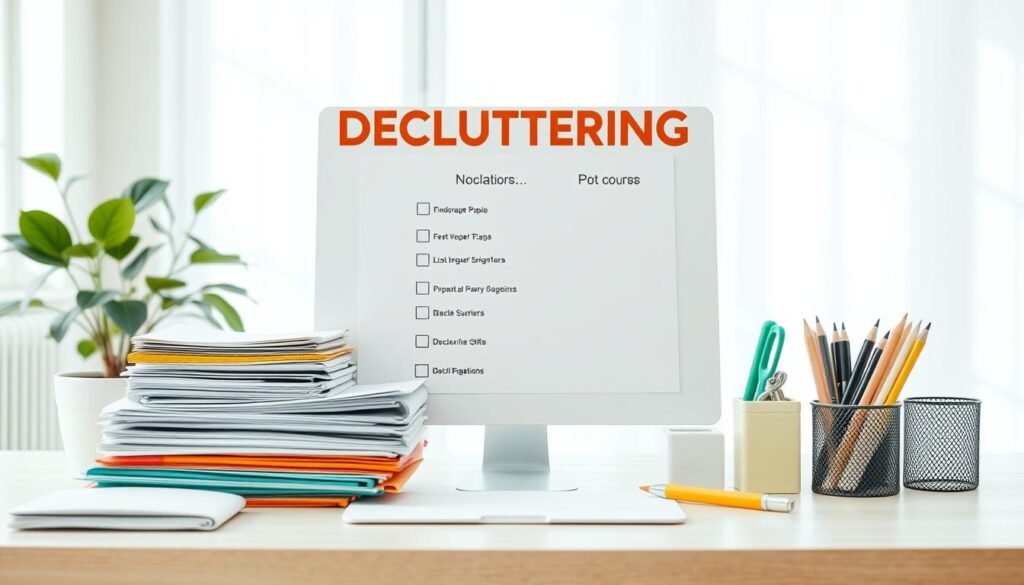
“The first step in crafting the life you want is to get rid of everything you don’t.” – Joshua Becker
Dealing with Emotional Attachments and Sentimental Items
Decluttering can be tough, especially with sentimental items. These items, like family heirlooms or childhood keepsakes, can stir up strong feelings. Yet, embracing minimalism means facing these feelings head-on.
The Swedish Death Cleaning Approach
The Swedish death cleaning method, or “döstädning,” is a good way to handle sentimental items. It asks you to think about what your loved ones would want to keep after you’re gone. This helps you decide if an item is truly valuable or meaningful to others.
Using the “Penalty Box” Method
The “penalty box” method is another useful tool. Put items you’re unsure about in a special area for 30 days. If you don’t miss them or need to get them back, it’s okay to let them go. This method helps you overcome the fear of losing memories.
Documentation and Letting Go
When dealing with emotional clutter, consider documenting items before letting them go. Take photos or write about them in a journal. This way, you keep the memory without the physical item. Remember, your experiences and relationships are more important than any sentimental items. By keeping only what’s truly important, you create a space that supports your well-being.
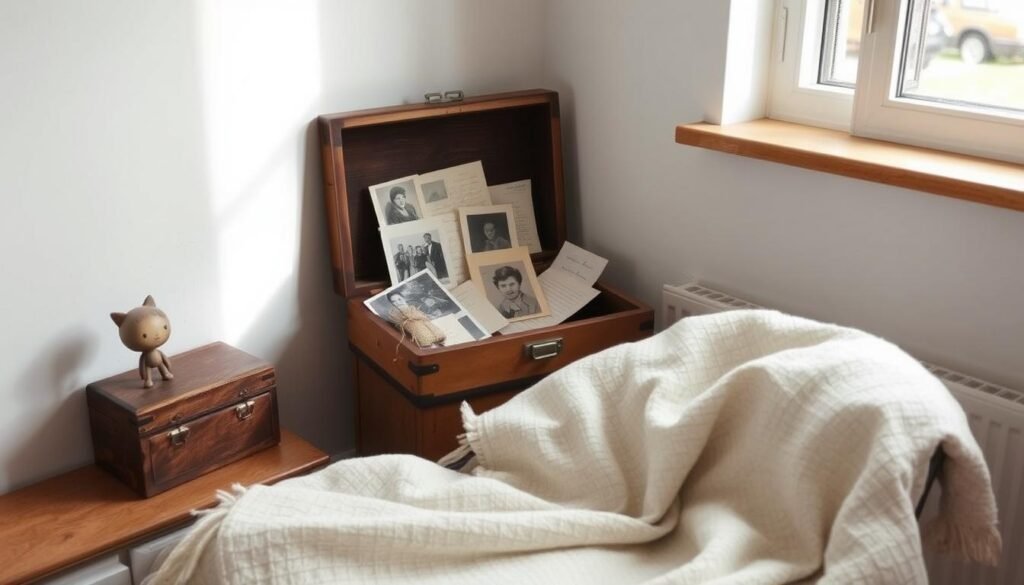
“The life you have left is a gift. Cherish it. Enjoy it now, to the fullest. Do what matters most to you, do what makes you feel alive, and do it often. And be bold, because the longer you live, the more you’ll realize that the only limitations are the ones you create.”
― Kristin Armstrong
Storage Solutions for Your Minimalist Space
Living minimally means having a clean, intentional space. To keep it that way, smart storage is essential. By using furniture that does more than one thing, vertical storage, and hidden spots, we keep our homes tidy. This way, everything has its place.
Modular storage, like tall cabinets, saves space and fits well with minimalist style. Smart drawer dividers and pull-out shelves make kitchen and bedroom storage better. A storage bed in the bedroom offers hidden space under the mattress.
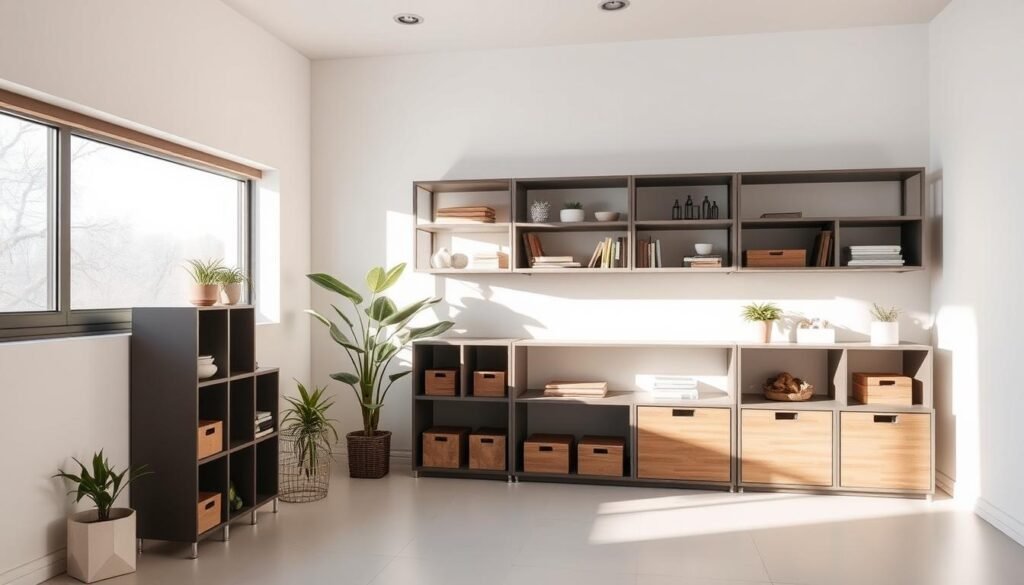
Vertical storage, like stackable containers, makes the most of unused space. Furniture that does double duty, like coffee tables with hidden spots, keeps the living room tidy. This way, we have less clutter but still look good.
Choosing the right storage means it fits our lifestyle and home. By checking our storage often, we keep our space organized and peaceful. This follows the minimalist design principles.
| Storage Solution | Benefits | Recommendation |
|---|---|---|
| Modular Storage | Provides space-saving solutions that fit a minimalist aesthetic | Floor-to-ceiling cabinetry, smart drawer dividers, pull-out shelving |
| Vertical Storage | Optimizes unused space, keeps items organized and accessible | Stackable containers, independent risers in tall cabinets |
| Multifunctional Furniture | Reduces surface clutter while offering ample storage | Coffee tables, ottomans, and other pieces with hidden compartments |
The aim of minimalist storage is not to hide clutter but to have a home for what we keep. By decluttering and keeping our storage in check, we enjoy a peaceful, organized space. This space follows the minimalist design principles.
ALSO READ: How To Create a Relaxing Bedroom Sanctuary
Conclusion
Embracing minimalism through decluttering can change your home and life. Everyone’s idea of minimalism is different. Find what makes you happy.
Stay motivated by looking back at your goals and celebrating small wins. Remember, living with less has many benefits.
Your decluttering journey might face challenges, but the outcome is worth it. You’ll have a peaceful, organized space.
By decluttering, you can get rid of 75% of your stuff. This leads to fewer distractions and a 5% boost in productivity.
Minimalist living can also cut your expenses by 10%. It helps you save and invest more. Plus, 86% of people feel clearer mentally after decluttering.
So, embrace the minimalism lifestyle. Create a stress-free space for intentional living!

